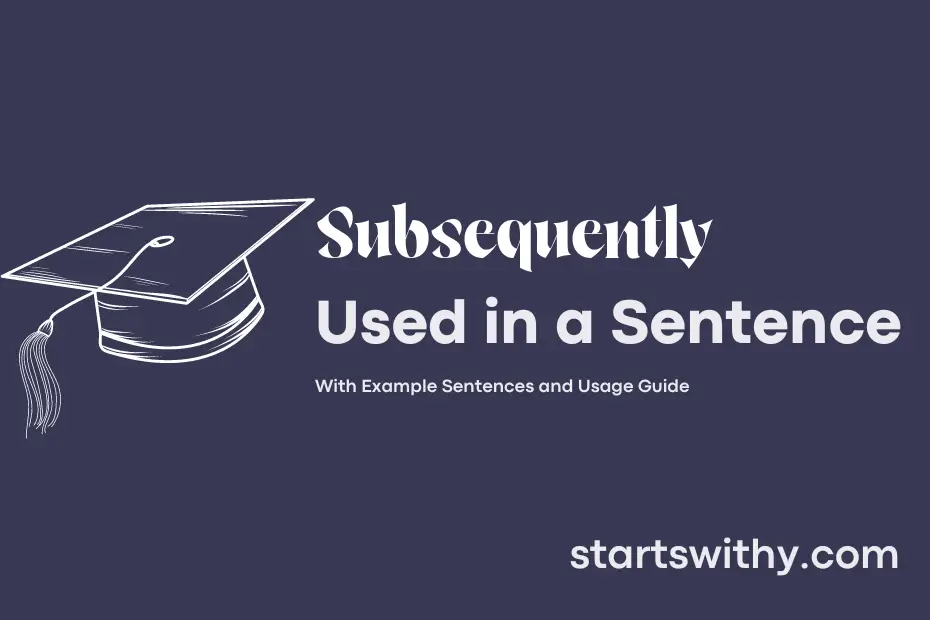Have you ever struggled to connect different parts of your writing seamlessly? The word “subsequently” can be the key to linking ideas effectively in your sentences.
When you use the word “subsequently” in your writing, you are indicating a logical sequence or order of events. This transitional word helps in illustrating the cause-and-effect relationship between different actions or consequences, guiding your reader through the progression of your ideas.
7 Examples Of Subsequently Used In a Sentence For Kids
- I woke up late, subsequently missing the bus to school.
- It started raining heavily, subsequently making the roads muddy.
- She forgot her lunch at home, subsequently feeling hungry during break time.
- The teacher explained the lesson clearly, subsequently all the students understood it.
- He sharpened his pencil, subsequently starting his coloring assignment.
- The bell rang, subsequently signaling the end of the class.
- She finished her homework quickly, subsequently getting time to play with her friends.
14 Sentences with Subsequently Examples
- Subsequently, I joined the college debate team to improve my communication skills.
- I attended the workshop on resume writing and subsequently updated my CV.
- Subsequently, I started a study group with my classmates to help each other prepare for exams.
- After attending the career fair, I subsequently applied for several internships.
- I participated in the coding competition and subsequently improved my programming skills.
- Subsequently, I joined the photography club to explore my passion for photography.
- I attended the seminar on time management and subsequently devised a study schedule.
- After failing the exam, I sought guidance from my professors and subsequently improved my grades.
- Subsequently, I volunteered for a social cause to give back to the community.
- I attended the networking event and subsequently connected with professionals in my field of interest.
- After attending the career counseling session, I subsequently switched my major to align with my passion.
- Subsequently, I started a fitness regime to maintain a healthy lifestyle.
- I attended the workshop on stress management and subsequently incorporated meditation into my daily routine.
- After receiving feedback on my project, I subsequently revised it to meet the requirements.
How To Use Subsequently in Sentences?
Subsequently means afterward or later on in time. It is a transition word that is used to show the order of events. Here is a helpful guide on how to use “subsequently” in a sentence:
-
Subsequently, we went to the store to buy some groceries.
This sentence shows that after one event (an unspecified action before going to the store), the next action was going to the store.
-
She studied hard for her exams, and subsequently, she received a high grade.
In this sentence, “subsequently” indicates that after studying hard, the result was receiving a high grade.
-
The company reported a drop in profits, and subsequently, many employees were laid off.
Here, “subsequently” connects the drop in profits to the subsequent action of laying off employees.
-
The weather forecast predicted rain in the morning; subsequently, the outdoor event was moved indoors.
This sentence illustrates that due to the predicted rain, the decision to move the event indoors was made afterward.
Remember, when using “subsequently,” make sure there is a clear sequence of events and that the second action follows the first. By incorporating this transition word into your writing, you can clearly indicate the order of occurrences in a sentence or text.
Conclusion
In conclusion, the effective use of transition words like “subsequently” in sentences can improve the flow of written communication, making it easier for readers to follow the sequence of events or ideas presented. By using “subsequently” to indicate a chronological order or cause-effect relationship between events, writers can create a clear and cohesive structure in their writing.
Furthermore, the use of transition words like “subsequently” can enhance the overall coherence and readability of a piece of writing, helping to maintain the reader’s engagement and understanding. Whether organizing a narrative, argument, or explanation, incorporating words like “subsequently” can assist in structuring the content in a logical and comprehensible manner.



